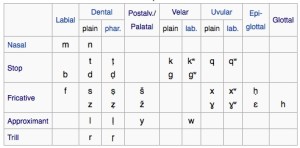Tachelhit

Tachelhit (Shilha, Soussiya, Southern Shilha, Susiya, Tachilhit, Tashelheyt, Tashelhit, Tashilheet, Tashlhiyt, Tasoussit) belongs to the Northern Berber group of the Afro-Asiatic language family. Tachelhit is the Berber name of the language, while Shilha is the general Arabic term for Moroccan Berber languages. One of the most widely spoken Berber languages, Tachelhit is spoken by 3.9 million people in primarily in Morocco, but also in Algeria and France (Ethnologue).
Status
Tachelhit has no official status neither in Morocco nor in Algeria. Many male speakers are bilingual in Tachelhit and Arabic, while women tend to be monolingual and not speak Arabic.
Dialects
Tachelhit has not been studied enough to ascertain differences in the regional varieties of the language. However, there is a difference between the spoken and written varieties of the language. The written variety contains more Arabic loanwords and grammatical constructions that are no longer used in the present-day spoken variety of the language.
Structure
The sound system of Tachelhit has a number of features that are common to other Berber languages.
Vowels
Tachelhit has three vowel phonemes, i.e., sounds that can differentiate word meaning.
|
Front
|
Central
|
Back
|
|
|---|---|---|---|
| Close |
i
|
xx |
u
|
| Mid | xxx | ||
| Open |
a
|
xx |
Consonants
Tachelhit has a very rich consonant system consisting of 32 phonemes, i.e., sounds that can differentiate word meaning. It has a number of unique features, some of which are detailed below.
- There is a variety of velar, uvular, pharyngeal and glottal consonants produced in the back of the oral cavity.
- There are both plain and pharyngealized consonants that are produced with a partial closure of the glottis during the articulation of the consonant.
- There is a distinction between labialized and plain velar and uvular consonants. Labialized consonants are produced with a simultaneous rounding of the lips while the sound is being articulate
- Like many Afro-Asiatic languages, native Tachelhit words do not have the consonants /p/ and /v/. These sounds occur only in borrowed words.
- Most consonants can be geminated (doubled). Geminated consonants are produced with a longer closure than their single counterparts
Below is a chart of Tachelhit consonants from Wikipedia.

- /ṭ, ḍ, ṣ, ẓ, ḷ, ṛ/ are pharyngealized consonants produced with a partial closure of the glottis during the articulation of the consonant. They have no equivalents in English.
- /q, x, ɣ/ have no equivalents in English.
- /kʷ, qʷ, gʷ, xʷ, ɣʷ/ are labialized consonants produced with a simultaneous rounding of the lips while the sound is being articulated. They have no equivalents in English.
- /ʡ/ is an epiglottal consonanti that s produced by obstructing airflow in the vocal tract.
- /š/ = sh in shop
- /ž/ = s in measure
Grammar
Nouns
Nouns are marked for the following categories:
- There are two genders: masculine and feminine.
- There are two numbers: singular and plural. Plural can be marked by affixation, e.g., a-fullus ‘rooster’ and i-fullus-n ‘roosters,’ or by vowel change, e.g., a-gayyu ‘head’ and i-guyya ‘heads’. Sometimes, both mechanisms are used, e.g., ass ‘day’ and ussan ‘days.’
- There are two cases: unmarked and marked. The unmarked case is used for subjects of verbs. The marked case is used after verbs, numerals and postpositions. It is marked by prefixation.
Pronouns
- Personal pronouns are marked for gender (masculine or feminine) in the 2nd and 3rd persons both in the singular and in the plural, e.g., keyy(in) ‘you’ masculine singular, kemm(in) ‘you’ feminine singular, netta(n) ‘he’ and nettat ‘she’.
- Personal pronouns have three cases: absolutive, direct object, and indirect object, e.g., nettat ‘she,’ (s)tt ‘her’ as direct object, a-s ‘her’ as indirect object.
- There are two sets of possessive pronouns, each used for specific purposes. The first set is used for kinship and part-whole relations, e.g., baba-k ‘your (m) father’. The second set uses the preposition nn ‘of’, e.g., tigmmi-nn-k ‘your house’, literally, ‘house of you’.
Verbs
- Tachelhit verbs agree with their subjects in person, gender and number.
- Person, gender and number of the subject are represented by affixes attached to verb roots.
- Verbs have several tense/aspect distinctions, e.g., aorist — non past form without tense marking; preterite representing the past tense; intensive — imperfective that represents habitual or durative action.
- There are three moods: indicative, imperative, and subjunctive.
- Imperatives are unmarked in the singular and marked for gender in the plural.
Prepositions
Most prepositions have a short and a long form. The long form is used with pronominal suffixes, while the short form is used in all other contexts, e.g. nniga-s ‘on top of him/her’, nnig- tgmmi ‘on top of the house’.
Tachelhit vocabulary is basically Berber, with numerous borrowings from Arabic, French and neighboring non-Berber languages.
Below are a few basic words and phrases in Tachelhit.
| Hello | ahlan |
| Good bye | bslama |
| Thank you | tanmmirt |
| Please | ‘afak |
| Sorry | samhiyi |
| Yes | yeh, wakha |
| No | oho |
| Book | ktab |
| House, home | tigimi |
Below are the numerals 1-10 in Tachelhit.
|
1
|
2
|
3
|
4
|
5
|
6
|
7
|
8
|
9
|
10
|
|---|---|---|---|---|---|---|---|---|---|
|
yan
|
sin
|
krad
|
kkuz
|
semmus
|
sdis
|
sa
|
ttan
|
ttza
|
mraw
|
Writing
Written Tachelhit differs from the spoken one because it contains archaic usage, more Arabic loanwords than the spoken language, and often represents a mix of several varieties.Tachelhit literature written in the Arabic script has been produced since the second half of the 16th century. There is no standard orthography for writing Tachelhit. It is written in both Arabic script and Latin alphabets.There is a push to teach and write Tachelhit using the Neo-Tifinagh alphabet.
Below is a Tachelhit folktale given here in Roman orthography (from Wikipedia). In Latin orthography, emphatic consonants are marked by a dot under the consonant. In addition, /Χ/ is written as x, /ʁ/ is written as γ, and /j/ is written y, š = sh in shop.
|
Lqiṣt n yan urgaz lli izznzan tammnt ɣ ssuq. Yan urgaz iɛmmr mnnaw yilmawn n tammnt ɣ ssuq. Yašk nn dars yan urgaz, ira ad dars isɣ tammnt. Inna yas: “Mnšk at tzznzt tammnt ann?” Inna yas: “Mḍi tt, iɣ tt tɛjb ar gis tsawalt.” Yasi urgaz ann yan yilm, ifsi t, imḍi tammnt, ifk t i bab nns, inna as: “Amẓ, ar kiɣ gussɣ wayyaḍ.” Yamẓ t s ufus nns, yasi daɣ umssaɣ lli wayyaḍ, ifsi t, imḍi tammnt, ifk t daɣ i bab nns. Yamẓ t s ufus nns yaḍnin, yasi umssaɣ yan yilm n tammnt, irur, iggammi bu tammnt mad an iskar i yilmawn lli yumẓ. Ar yaqqra i mddn at t fukkun. |
|
The story of the man who sold honey in the souk A man was filling some leather bags of honey in the souk. There came another man to him, who wanted to buy honey. He said: “At how much do you sell that honey?” The seller said to him: “Just taste it, and if it pleases you, make a bid.” The man took a bag, poured out some, tasted the honey and gave it back to its owner; he said: “Please hold it, so that I can try another one”. The seller held it in his hand, the buyer took another bag, poured out some, tasted the honey and gave it back to its owner, who held it in his other hand. Then the man took another bag of honey and ran away. The seller could not do anything because of the bags he held. He called for help until they liberated him. |







